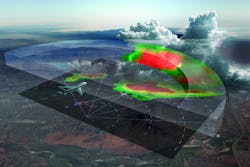3D Radar’s Long-Range Hazard Detection Quickens Flight Rerouting
While traditional radar systems typically focus in on one specific area at a time, a new 3D weather radar can analyze data from 17 different angles simultaneously. Honeywell’s IntuVue 3D radar utilizes volumetric 3D scanning and pulse-compression technologies to provide pilots with a more complete view of the weather, at a greater resolution. This helps improve strategic maneuvering for rerouting and reduces the risk of encountering hazardous weather.
The IntuVue system, which fits into the nose cone of a plane, collects and automatically corrects data for earth curvature, offering a 180° display at 320 nautical miles (nmi) from the aircraft. Automatic scan and ground clutter extraction helps ensure that the most reflective part of a storm is displayed, and that hazardous cells below the aircraft’s flight level can be identified earlier and displayed longer than traditional systems. The system also includes advanced predictive windshear detection and alarming, which is said to reduce false alarms by about 90%. Its fully automated weather detection ultimately will reduce pilot workloads.
The aggressive down-tilt and 3D scanning process builds in inherent over-flight protection. IntuVue is also certified to the FAA Minimum Operating Performance Standard (MOPS) for enhanced turbulence—extended turbulence detection range reaches 60 nmi. Overall, the system helps to minimize the financial impact of severe storm activity while aiming to provide efficiency, safety, and performance.
About the Author
Iliza Sokol
Associate Digital Editor
Iliza joined the Penton Media group in 2013 after graduating from the Fashion Institute of Technology with a BS in Advertising and Marketing Communications. Prior to joining the staff, she worked at NYLON Magazine and a ghostwriting firm based in New York.

